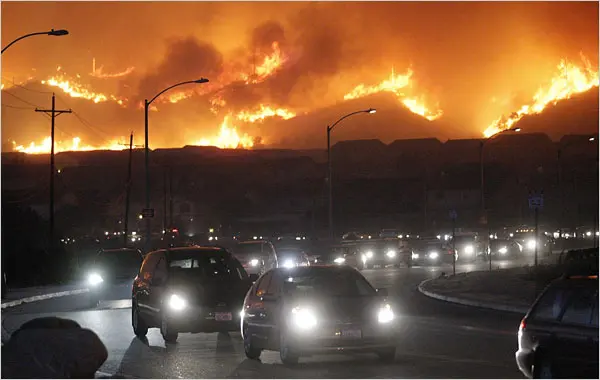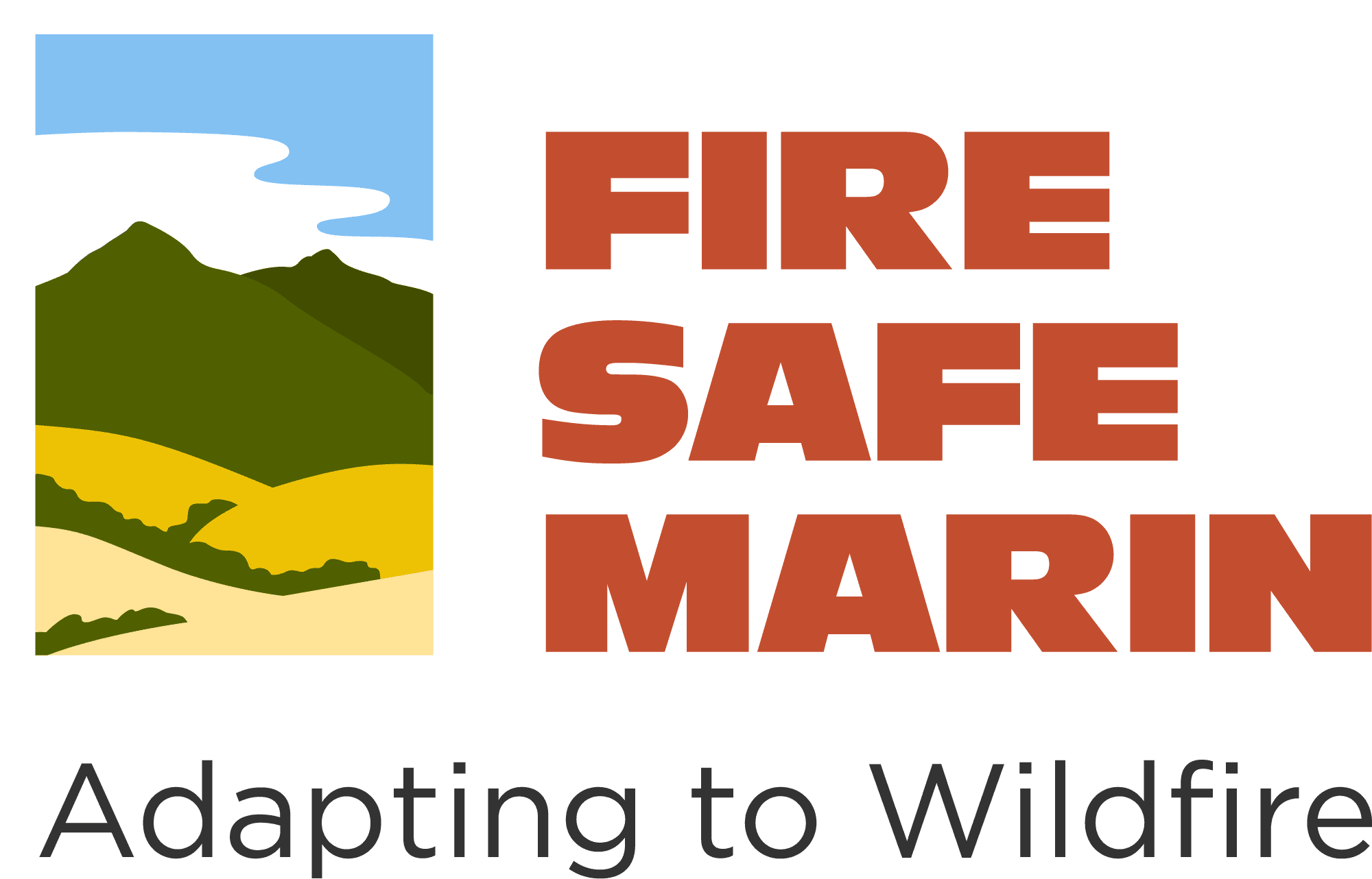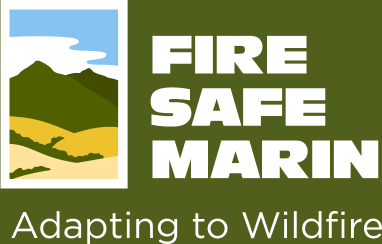
Wildfire Preparedness Week is May 3-9, 2015. Follow our daily updates for an easy, step by step guide to protecting your home!
This week, Fire Safe Marin will provide a simple, 7 day guide to improving your home and family’s wildfire preparedness with simple, easy, inexpensive tips.
Day 6: Go! Create and Evacuation Plan
Ready, Set, Go. If you’ve followed days 1-5 of our Wildfire Preparedness Week step-by-step planning guide, you’ve now taken steps to “Ready” your home for wildfire, and are “set” to evacuate when the time is right. Today we’ll look at the last step in a process that we hope you’ll never face – evacuate.
Evacuations save lives and allow responding personnel to focus on the emergency at hand. Please evacuate promptly when requested! Your life is at stake!
By leaving early, you give your family the best chance of surviving a wildfire. You also help firefighters by keeping roads clear of congestion, enabling them to move more freely and do their job.
WHEN TO LEAVE
Leave early enough to avoid being caught in fire, smoke or road congestion. Don’t wait to be told by authorities to leave. In an intense wildfire, they may not have time to knock on every door. If you are advised to leave, don’t hesitate!
WHERE TO GO
Leave to a predetermined location (it should be a low-risk area, such as a well-prepared neighbor or relative’s house, a Red Cross shelter or evacuation center, motel, etc.)
HOW TO GET THERE
Have several travel routes in case one route is blocked by the fire or by emergency vehicles and equipment. Choose an escape route away from the fire.
WHAT TO TAKE
Take your emergency supply kit containing your family and pet’s necessary items.
The Law
California law authorizes officers to restrict access to any area where a menace to public health or safety exists due to a calamity such as flood, storm, fire, earthquake, explosion, accident or other disaster. Refusal to comply is a misdemeanor. (Penal Code 409.5)
Evacuation Orders
The terms Voluntary and Mandatory are used to describe evacuation orders. However, local jurisdictions may use other terminology such as Precautionary and Immediate Threat. These terms are used to alert you to the significance of the danger. All evacuation instructions provided by officials should be followed immediately for your safety.
Long Before a Fire Threatens
Prepare an Evacuation Checklist and Organize (see: Wildfire Preparedness Week, Day 5: Now that You’re Ready, Get Set!)
- Critical medications
- Important personal papers, photos.
- Essential valuables.
- Pet and livestock transport, limited amount of pet food.
- Change of clothing, toiletries.
- Cell phone.
- Critical papers and effects in a fire-proof safe.
- An Evacuation Route Map with at least two routes.*
- Drive your planned route of escape before an actual emergency.*
*During an evacuation, law enforcement/ emergency personnel may determine your route.
If Evacuation is a Possibility
 Locate your Evacuation Checklist and place the items in your vehicle.
Locate your Evacuation Checklist and place the items in your vehicle.- Park your vehicle facing outward and carry your car keys with you.
- Locate your pets and keep them nearby.
- Prepare farm animals for transport.
- Place connected garden hoses and buckets full of water around the house.
- Move propane BBQ appliances away from structures.
- Cover-up. Wear long pants, long sleeve shirt, heavy shoes/boots, cap, dry bandanna for face cover, goggles or glasses. 100% cotton or wool clothing is preferable if you have time.
- Leave lights on in the house and outdoors, and your door unlocked.
- Leave windows closed, and air conditioning off.
The Evacuation Process
Officials will determine the areas to be evacuated and the routes to use depending upon the fire’s location, behavior, winds, terrain, etc. Law enforcement agencies are typically responsible for enforcing an evacuation order.
Follow their directions promptly.
You will be advised of potential evacuations as early as possible. You must take the initiative to stay informed and aware. Listen to your radio/TV for announcements from law enforcement and emergency personnel.
You may be directed to temporary assembly areas to await transfer to a safe location.
If You Become Trapped
While in your vehicle:
- Stay calm.
- Park your vehicle in an area clear of vegetation.
- Close all vehicle windows and vents.
- Cover yourself with wool blanket or jacket.
- Lie on vehicle floor.
- Use your cell phone to advise officials – Call 911.
While on foot:
- Stay calm
- Go to an area clear of vegetation, a ditch or depression if possible
- Lie face down, cover up
- Use your cell phone to advise officials – Call 911
While in your home:
- Stay calm, keep your family together
- Call 911 and inform authorities of your location
- Fill sinks and tubs with cold water
- Keep doors and windows closed, but unlocked
- Stay inside your house
- Stay away from outside walls and windows
* Note – it will get hot in the house, but it is much hotter, and more dangerous outside.
After the fire passes, and if it is safe, check the following areas for fire:
- The roof and house exterior
- Under decks and inside your attic
- Your yard for burning trees, woodpiles, etc
Returning Home

Fire officials will determine when it is safe for you to return to your home. This will be done as soon as possible considering safety and accessibility.
When you return home:
- Be alert for downed power lines and other hazards
- Check propane tanks, regulators, and lines before turning gas on
- Check your residence carefully for hidden embers or smoldering fires
Learn more at www.readysetgomarin.org, and watch tomorrow for the final, Day 7, of our Wildfire Preparedness Week series. Download a ![]() Ready, Set, Go “Action Guide”for more information and checklists.
Ready, Set, Go “Action Guide”for more information and checklists.
Did you read our earlier articles?
Wildfire Preparedness Week, Day 5: Now that You’re Ready, Get Set!
Wildfire Preparedness Week, Day 4: Choose Firewise Plants
Wildfire Preparedness Week, Day 3: Expand Your Defensible Space
Wildfire Preparedness Week, Day 2: Cut Your Grass!
Wildfire Preparedness Week, Day 1: Clean Your Roof and Gutters!







